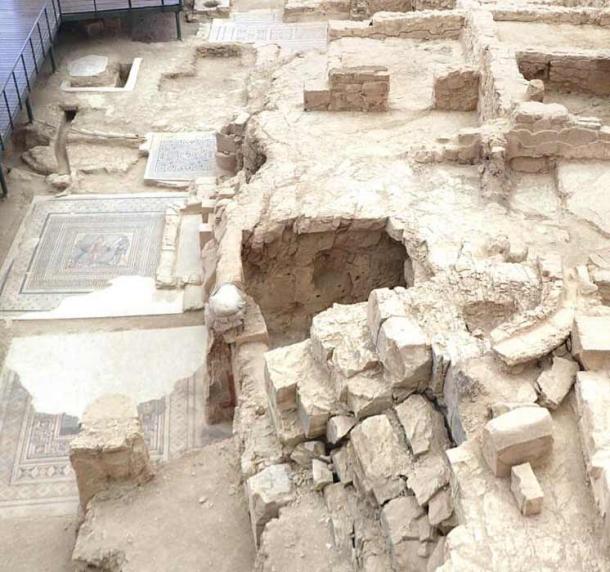
Rock-Cut Banquet Rooms Found At The House of Muses, Zeugma
Two rock chambers have been discovered deep beneath the House of Muses in Zeugma, Turkey. Signifying the intellectual level, wealth and power of a wealthy family, these two chambers can be seen as customized high-society “party pods.”
Founded in 300 BC by Seleucus I Nicator, one of the generals of Alexander the Great, the ancient city of “Seleukia-on-the-Euphrates” is located in modern Gaziantep province. The city was strategically located across the Taurus Mountains from Anatolia and across the Euphrates from Mesopotamia, where the Euphrates River rounds its furthest bend to the west, at which point it starts to flow southwards into the Syrian desert.
In 64 BC the city was conquered by the Roman Empire and was renamed Zeugma. At that time, the city had a population of around 80,000 inhabitants. Excavations began at this ancient metropolis in 2005.
In 2007 Prof Kutalmis Görkay, of Ankara University, unearthed “three highly-intact, 2,200-year-old, stunning mosaics.” The Zeugma mosaics display exquisite detail and beauty, especially on the "Gypsy Girl” and on the famous “Nine Muses” mosaics. However, the intrepid Professor Görkay, who stands at the forefront of Hellenistic and Roman archaeology on the Euphrates frontier, has now discovered two new rock chambers in the legendary “House of Muses.”

The Nine Muses mosaic uncovered at the Zeugma site in 2014. (Ankara University)
The Lost Chambers of Zeugma Promise to Tell Us More!
Hurriyet Daily News report that Professor Görkay said the two rock chambers were found after 16 meters of earth fill was excavated from the House of Muses. The archaeologists then began excavating inside the rock chambers, but they soon identified a series of “risky cracks” on the ceilings.
- Astonished Archaeologists Find Roman Colosseum Replica in Anatolia
- The ancient underground city discovered beneath a house in Anatolia
The professor says the excavations will be completed later this year after the two chambers are secured with a support structure. Furthermore, the protective measures, which include “injections or steel structures” will serve to safeguard the public when the site opens after the works are completed.

Rock-cut chamber discovered at the Zeugma site. (Kutalmış Görkay / Hurriyet Daily)
The professor said the ancient city of Zeugma was “one of the most important cities in Anatolia, especially on the Eastern Roman border.” Excavations in the House of Muses have provided important information about the private lives of the inhabitants of Zeugma and these two newly discovered rock chambers greatly add to this unfolding volume of ancient knowledge.
Professor Görkay believes the two rock chambers were used as dining rooms and that they “show traces of the intellectual life of its owner at that time.”
The latest Zeugma rock chamber discovery process and excavation was filmed and can be viewed via this link.
Partying In The Shadows Of The Muses at Zeugma
Görkay said “Muses are the most important personifications of classical Greek education, especially in antiquity.” The deities depicted in the mosaics can all be associated with “Greek literature, history, poetry and music,” which all reflect education and culture. But perhaps the greatest show of education, wealth, power, and the resulting “culture” was the feast, hence, the two dining room chambers represent further signs of a costly, classical education.
- The Ancient Greeks Had Alternative Facts Too
- Archaeologists Discover Paintings of Ancient Egypt in a 2,000-Year-Old Villa in Pompeii
The archaeologists at Zeugma interpret the site as having belonged to a family with “a better than the middle-class economy.” This is indicated not only in the presence of the highly-ornate muses, but in the two dining rooms, for they were located beside luxurious courtyards.
The courtyards were wide open spaces where rainwater was trapped in collection basins. But they were also grand landscaped areas suited for luxury dinner parties. When visiting nobility, wealthy traders and army commanders arrived at Zeugma they would have been taken to the courtyard where the basins of water provided a cool environment.
Later, in the balmy evenings, the two rock chambers would have come alive with music, dancers, food and wine. When visitors left they would spread stories far and wide about their cultural experience in the party chambers at Zeugma.
Top image: Just one of the many Zeugma mosaics found in a high-class home in Zeugma, Turkey. It was in this home, the House of Muses, that two new rock chambers were recently discovered. Source: Bulent SARI / Adobe Stock
By Ashley Cowie















